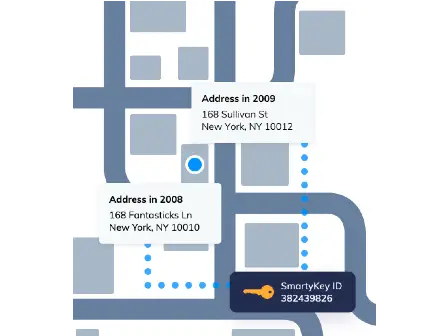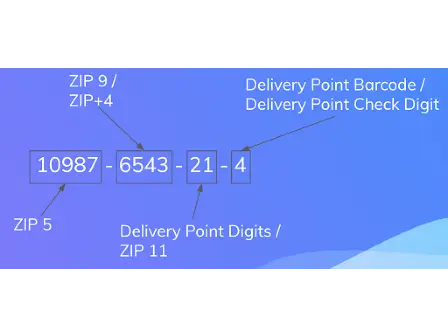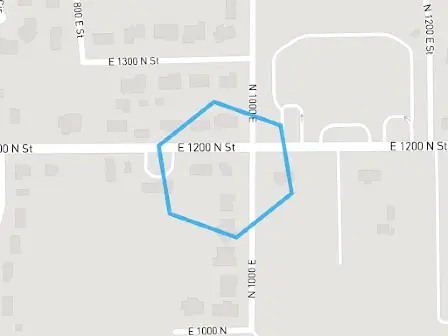Address key - The persistent unique identifier (or fingerprints) for addresses

An Address Key is a persistent unique identifier for every unique physical street address. The unique address key remains with the delivery point forever, regardless of how often the address changes over time. Address keys help solve many data management problems, as described in this article.
Think of an address key like a person's fingerprint. William has unique fingerprints; nobody in the world has the same. But William is known by various alias names by his mom, grandparents, siblings, nieces and nephews, colleagues, enemies, and the FBI.
William goes by Will, Willy, Willie, Wee Willie Winkie, Bill, Billy, Billie, Little Bill, Big Bill, Liam, Iam, Willem, and Will I Am.
No matter how many alias names William has, he only has one set of fingerprints uniquely identifying him for life.
Likewise, a single, unique location might be known by many alias locations but have a unique fingerprint, which is the location's address key and persists forever.
Check out our single and bulk address validation tools. Click the "TRY IT NOW" buttons, or learn more about our US Master Address List by clicking "LEARN NOW."
| Single Address Validation | Bulk Address Validation | US Master Address List |
|---|---|---|
This article will cover:
- How do address keys work?
- 3 Approaches to creating address keys
- What makes a GOOD address key?
- What makes a GREAT address key?
- Why is an address key important?
- Address keys that don't work as persistent unique identifiers
- Address keys that do work as persistent unique identifiers
- Address key provider comparison
- Key-takeaways
How do address keys work?

Address keys assign a unique key to every unique, precise address. The keys are address identifiers. A unique, precise address can have multiple aliases; some have more than 20. Aliases are created due to typos, misspellings, and address changes. Addresses having aliases all share the same address key.
Let's look at a few address key examples.
Maybe the address is on the corner of Happy and Healthy (yes, a Walgreens reference) and is known as 101 Happy Street and 101 Healthy Avenue. These are duplicate alias mailing addresses for the same place and will share the same address key.
Here's a real-life example. 168 Fantasticks Ln, New York, NY 10010 is an alias location of 168 Sullivan St, New York, NY 10012. Both are valid street addresses for the same business location, even though the street names and thus, mailing addresses, are completely different.
Computers looking for duplicate address strings would miss this type of a duplicate. Things sent to either address go to the same delivery location. A properly applied address key would be the same for both addresses to help you identify and deal with duplicate alias locations in your database.
Address keys are assigned to the most correct version of each address and act as a single source of truth that simplifies address database management.
3 Approaches to creating address keys
People have tried different approaches to creating unique address keys. Three approaches to address keys are the GUID, component, and integer.
Globally-unique identifiers (GUID)
Globally-unique identifiers (GUIDs) are comprised of 32 hexadecimal characters. Here's an example GUID: 23bd4e2e-g441-8bbf-990b-bdd7943ggf92.
The pros of using GUIDs as unique address keys are that they're unique. The main cons are that they're large, hard to read, clumsy, and take up a lot of storage space. GUIDs use 16 bytes of storage.

Address components
Another approach to creating an address key is to use components of the address itself.
Some companies have used the delivery point code, an eleven-digit number composed of the delivery point's nine-digit ZIP+4 Code plus 2 digits indicating a unique address. (The twelfth digit acts as a check digit.)
A pro of the component approach is that its integer is unique to a delivery point at the time of the key creation. The main con is that ZIP Codes and street numbers change, which means delivery point codes also change, leading to confusion.
Integers
The final approach we'll consider to create a unique address key is the use of randomly generated integers. Integers of about 10 digits are randomly generated and assigned to every address.
The integer approach overcomes the cons of the GUID and component approaches.
Integers are smaller, faster, and easier to deal with than GUIDs. 10-digit integers only require 4 bytes of storage space, one-quarter of the space of a GUID. The reduced size can make a performance difference in large applications.
Unlike delivery point codes, integer keys can be persistent, meaning they never change regardless of how the address changes.
What makes a GOOD address key?
For most use cases, good address keys should be:
Unique
Good address keys should be unique to every delivery point location. Aliases for a single delivery point share the same address key. The uniqueness of the key helps identify, merge, and deduplicate alias locations.
Persistent
Address keys should be persistent. This means they should never change despite changes to the attached addresses. This helps avoid confusion in data management and reporting.
Simple
Generally speaking, simple, short address keys are better than complex, long address keys. Simplicity and smaller size help with data processing performance and data management.
Current
While address keys should never change, the underlying address data does. Good address keys update the underlying address data regularly to provide the most accurate address data.
Protect PII
A good address key will also help you protect the personally identifiable information in your database. Address keys should not contain components of identifiable information, like an address.
Address keys should be randomly generated and assigned rather than sequential, so there's no chance of reverse engineering them. This way, address keys help you anonymously share and keep data private.
What makes a GREAT address key?
Well, in short, SmartyKey®, our persistent unique identifier, does because it has all of the things listed above and more.
As part of our SmartyKey updates, we decided to make a good thing even greater. With the purchase of our Master Address List, SmartyKey comes with a little extra juice, SmartyKeyEXT.
If SmartyKey is the fingerprint, then SmartyKeyEXT is the finger that the print belongs to. Let me explain.
Many addresses have aliases, but this is especially true for large buildings. Consider the plethora of delivery points in a hospital, the Empire State Building, or a retirement community. Companies looking for a drop-off or pick-up zone for materials or customers will need more than just the address to find the right place.
SmartyKeyEXT is an additional field our clients use to make the cutting-edge distinction of where to go. Uber, for example, uses this technology to make sure that they drop off your food or medication at the right spot every time. Still, this information is essential for any organization dealing with alias location headaches.
Why is an address key important?
Address keys are important because they help solve myriads of data management problems such as data updates, duplicates, data blending, processing time, and personally identifiable information.
Address keys help update address changes
Addresses are more fluid than most people know. Change is constant. Every year, hundreds of thousands of addresses change in the US alone, causing bad data, confusion, and other address management headaches.
As mentioned above, while address keys should never change, the underlying address data does. Good address keys update the underlying address data regularly, so you always have the most accurate address data for consistent, non-confusing data management purposes.
Bonus: Wondering why addresses change? Here's a brief breakdown by street number, street name, city name, and ZIP Code.

Street numbers
Street numbers change for a variety of reasons. They change to resolve duplicates, help first responders more quickly locate emergencies, and fit the sequence with the rest of a street as it's further developed. Changes to street numbers also include fixing errors in USPS data.
In some cases, street numbers are wiped off the face of the earth due to natural disasters.
You can, and people do, change house numbers. Maybe you bought the Munster's old house at 1313 Mockingbird Lane, and you're sure your street number is the cause of a recent string of bad luck. Or maybe you're tired of telling people you live at 666 Devils Way. Want to change your address? Often, the starting point is your local zoning administration office.
Street names

Street names also frequently change. For example, 1230 North in Provo, Utah, was changed to Bulldog Boulevard in honor of the adjacent high school's mascot. After the high school moved to a new location, a local university purchased the old school building, and the road was quickly renamed Cougar Boulevard after the university's mascot.
Streets are also frequently renamed for people who have provided extraordinary public service or some exemplary contribution to the public.
For example, maybe you've been around long enough to notice a street name change to Martin Luther King Street. Now, there are more than 900 such street names in the United States. Everyone who lived at or worked on those streets had address changes. That can make a mess of your address database.
City names
City names change, too. More than 300 US cities have had former names. Los Angeles was once known as "El Pueblo de Nuestra Señora la Reina de los Ángeles de la Porciúncula," which translates to "The Town of Our Lady the Queen of the Angels of Porciúncula."
City names often change to correct insensitivities in the past. For example, "squaw" is considered a racist and sexist term for Native American women, but still, nearly 800 places in America include "squaw" in their name, some of them being cities. Think of Squaw Valley, California.
The Reconciliation in Place Names Act was recently introduced, which would rename those locations. When any of the affected cities' names change, all residential and business addresses in those cities will change, causing duress to data managers.
ZIP Codes
Each year, new ZIP Codes are created, and existing ones change. Populations increase, boundaries realign, and delivery routes change.
As the authority for mailing addresses in the US, the United States Postal Service (USPS) owns the ZIP Codes and frequently changes them to improve postal operations.
The +4 Codes at the end of a 9-digit ZIP Code also change frequently. The +4 indicates a specific delivery route, meaning the mail truck's actual path.
Due to new developments, remapping, and changes in the number of postal employees, some +4s can change as frequently as monthly. Learn more in our Zip+4 Code Lookup article.
Address keys make data blending easier and more accurate
Do you have non-matching, duplicate address data entering your database from multiple sources?
Most companies do. Common sources include customer support, sales, customer success, lead forms, checkout forms, and 3rd-party sources like trade show leads sent to you in .csv files.
It's easy to see how contact and customer data in your CRM and other databases can quickly become a hot mess to the frustration of leadership, sales, marketing, support, data managers, and everyone else.
Why is it so hard to avoid conflicting data?
Maybe addresses are updated in one dataset but not the others. This inconsistency can happen while customers are on the phone with support or sales.
Or, prospects and customers create duplicate records by entering their addresses differently with each form they submit. Here are a few ways customers can enter your database with different addresses:
Abbreviation of street: Say John Smith is already in your database at 55 West Smarty Street. John downloads a gated white paper but enters his street address as 55 West Smarty St; where the second time he filled out the form, he used "St" to abbreviate "Street." Poof - a duplicate address just entered your system.
Abbreviation of predirectionals: Later, John enters his address as 55 W Smarty Street, abbreviating "West" as "W." Poof - another duplicate record.
Mistyped addresses: Again, John completes a form and mistypes his address. Poof - another duplicate.
Look at how many new customers you're getting! Leadership will be thrilled. Not.
Interestingly, while your computer won't recognize John's variant addresses as the same place, you and I can do so easily. If you're not busy, manually correcting thousands of addresses daily can be fun.
Let's make things worse.
A single, unique delivery point can have multiple, valid, deliverable addresses. For example, a street name change can result in two valid USPS delivery addresses.
Are you sending your marketing materials, samples, and other promotions to both addresses?
Frustratingly, fraudsters intentionally submit alias locations through your forms to get extra free trials or product samples and scam you in other ways. With alias locations, you feel the pain of fraud, duplicate mailings, unnecessary postage costs, annoyed customers, and inaccurate reporting.
Now for the good news - address keys and validation can help you efficiently clean up, standardize, and deduplicate addresses. Together, they'll reduce confusion, cut data bloat, increase processing speed, avoid wasted shipping, refine operations, generate accurate reports, improve business processes, and aid decision-making.
In the case of valid, deliverable aliases, an address key provider, like Smarty, will have already identified the duplicates and assigned the same address key to all valid versions of the address, making dealing with duplicate addresses a breeze.
With duplicates identified, data blending is more manageable, even for massive datasets. You can more easily join valid alias locations in different datasets with confidence, as they'll share the same address key.
In the case of invalid, non-deliverable address variants, you can apply address validation, like that from Smarty with enhanced matching, to standardize and match even messy addresses across disparate sources. You can then merge or deduplicate records.
Address keys reduce processing time
Simple, single-field address keys are inherently easier to manage and use, are data-light, and are fast to process. A 10-digit integer key requires just 4 bytes of data storage, which can be 1/10th of a complete address in multiple fields.
Address keys improve the speed of searching and matching records. They reduce system processing demands as you store and transmit data more efficiently.
Tip: To further reduce processing requirements and server time when updating your addresses, just update the records that have changed from month to month rather than the entire dataset.
Address keys help protect personally identifiable information
Good address keys are randomly generated, don't include personally identifiable information, and can't be reverse-engineered. Nobody can decipher address information from properly created address keys.
Users can only decode keys by querying the source that generated them. Keys help maintain data anonymity and add another layer to the security of your data.
Need to share data outside your organization? Avoid moving personally identifiable information associated with addresses. Send the address key in place of the address to help ensure anonymization and compliance with privacy laws.
Address keys that don't work as persistent unique identifiers
There are some misconceptions around address key functionality that can be helpful to know about before adopting them. People use various keys as persistent or permanent location keys only to find they don't work as intended. Let's take a look at a few.
Google Place ID
What is a Google Place ID?
This comes from Google's Places ID documentation:
A place ID is a textual identifier that uniquely identifies a place. The length of the identifier may vary (there's no maximum length for Place IDs). Example:
- ChIJgUbEo8cfqokR51P9_Wh_DaM
- GhIJQWD10CIeQUARxks3icF8U8A
- EicxMyBNYXJrZXQgU3QsIFdpbG1pbmd0b24sIE5DIDI4NDAxLCBVU0EiGhIYChQKEgnRTo6ixx_bbmkCm7ZRAN
Are all locations assigned a single, unique Place ID?
"It is possible for the same place or location to have multiple different place IDs."
Are Place IDs persistent and unchanging?
"Place IDs may change over time...Place IDs may change due to large-scale updates on the Google Maps database. In such cases, a place may receive a new place ID, and the old ID returns a NOT_FOUND response."
If you want to use Google's Place IDs, be aware that they can be unwieldy in length, they can get confusing with multiple IDs for the same location, and they won't work as persistent unique identifiers because they can change over time.
PlaceKey

PlaceKey is a free, universal standard identifier for any physical place. Built on Uber's open-source H3 grid system, it covers the planet in 15,000 square meters (3.7 acres) hexagons. It's kind of cool. Here's an example of a PlaceKey on a residential street map:
Notice that multiple delivery locations (houses in this example) inside the hexagon share the same PlaceKey.
Also, notice that some houses and properties are partially inside and outside the hexagon. This confusion is mostly solved by only including locations whose centroid point falls within the hexagon.
From PlaceKey's website:
"Can a Placekey churn or change?
Of course... And sometimes Placekey will have bugs (we are not perfect)."
So, unfortunately, while PlaceKeys are universally unique identifiers (UUID), they are not persistent unique identifiers (PUID), and that can mean data management confusion and headaches you likely don't want to deal with.
USPS Delivery Point Barcode
The USPS Delivery Point Barcode (DPBC) is made up of an 11-digit integer. It consists of the location's 5-digit ZIP Code, +4 digits, and the last two digits of the delivery address. The post office converts the integer into a barcode for improved mail processing.
Because ZIP Codes and street address numbers change, the DPBCs also change. For example, today, a specific address could be represented by a code of 90210512454, but tomorrow, the location could be represented by a different DPBC due to address changes. The DPBC isn't a persistent unique identifier.
Address keys that do work as persistent unique identifiers
Address service experts, like Smarty, have proprietary methods for creating ideal persistent unique identifiers associated with addresses.
Smarty's SmartyKey® is a persistent, unique, 10-digit address key. Smarty assigns unique, non-sequential, randomly generated keys to all 220 million+ USPS deliverable addresses in the United States.
SmartyKeys are persistent unique identifiers (PUIDs) that never change and remain with a location forever, regardless of any address changes.
SmartyKey® metadata identifies all alias locations in the US Master Address List. The most correct version of the address is indicated and shares the same SmartyKey® with all aliases for simple deduplication and data blending.
SmartyKeys are applied to secondary addresses, such as apartments and suites. SmartyKey® metadata in the US Master Address List shows the relationship between primary and secondary addresses and the number of secondary addresses associated with every primary address. This metadata also indicates whether a location is residential or commercial.
The address metadata underlying a SmartyKey® is automatically updated monthly to capture all address changes and ensure your address data is always accurate.
SmartyKey® offers all the features of a good address key, plus more.
Address key provider comparison
| SmartyKey | Google Place ID | Placekey | USPS DPBC | |
| Positively identifies unique locations | ✅ | ✅ | ✅ | ✅ |
| Helps protect personally identifiable information | ✅ | ✅ | ✅ | ✅ |
| Saves disk space | ✅ | Not always | ✅ | ✅ |
| Reduces manual exception work | ✅ | Not always | Not always | Not always |
| Helps deduplicate and blend records | ✅ | Somewhat | Somewhat | Somewhat |
| Improves speed and accuracy of searching and matching records | ✅ | Not always | Not always | Not always |
| Identifies all 210 million+ deliverable addresses in the U.S. | ✅ | ❌ | ❌ | ❌ |
| Reduces confusion as a persistent unique identifier that never changes | ✅ | ❌ | ❌ | ❌ |
| Ties primary and secondary addresses together | ✅ | ❌ | ❌ | ❌ |
| Ties all alias locations to the most correct version | ✅ | ❌ | ❌ | ❌ |
| Includes data such as county and the residential/commercial indicator | ✅ | ❌ | ❌ | ❌ |
Key takeaways
A persistent, unique address key acts as a single source of truth that improves address data accuracy, blending, understanding, processing, reporting, analysis, decision-making, and management.
SmartyKeys are available through Smarty's US Master Address List, US Address Verification, all data enrichment products, and all US geocoding products. See for yourself how access to Smarty's US Master Address List with 210+ million verified mailable addresses can benefit you and your company.
For even the most massive address files, address keys help improve continuity, consistency, confidence, and trust in your data.